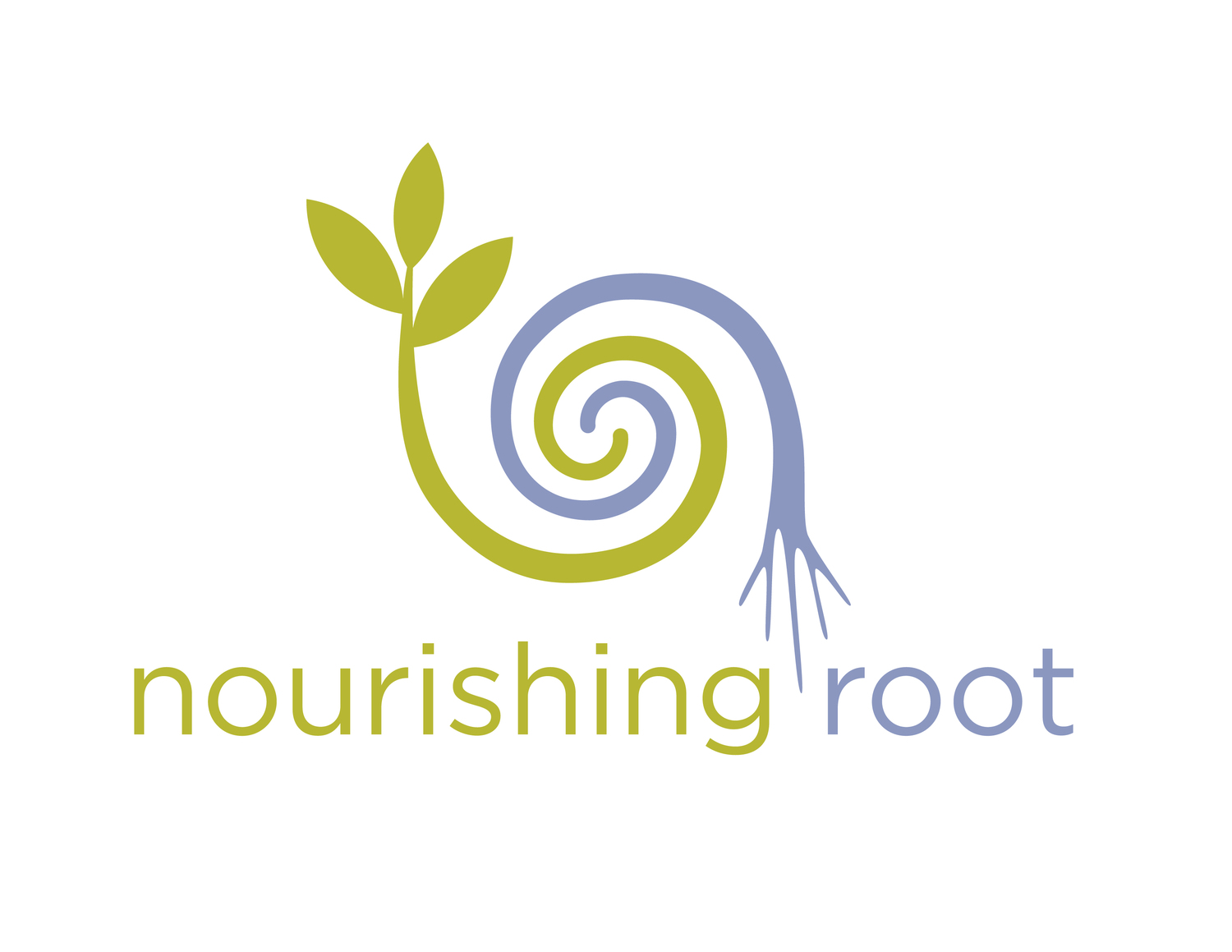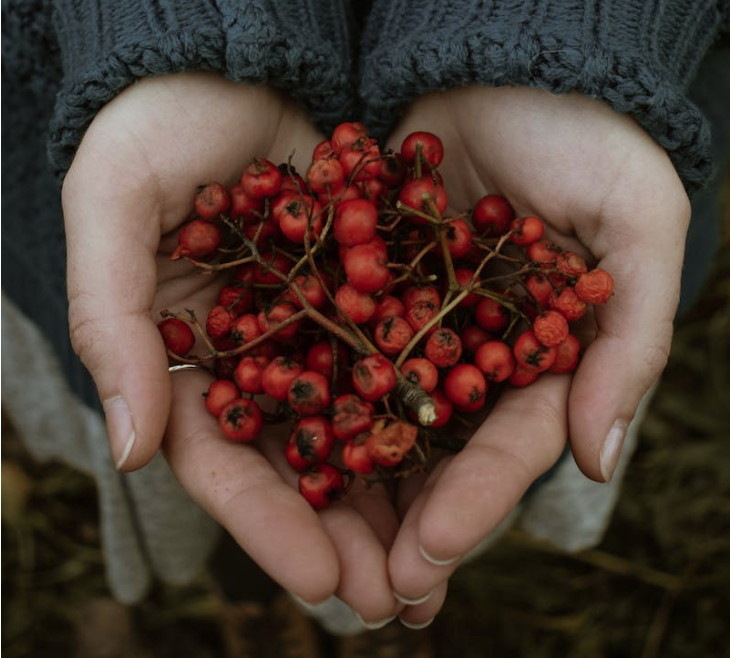As we move into winter, let’s look at warming herbs ginger and hawthorn, plus some foods and spices.
Ginger, Zingiber oficiale, is the easiest go-to for warming up in the winter. Readily accessible, ginger is valued across the world for numerous reasons, including its antiinflammatory, digestive and circulatory properties. Ginger as a circulatory tonic is just as valuable in the hot weather as it is in the cold because it aids peripheral circulation, moving blood to the extremities. In the summer, this increased peripheral circulation facilitates sweating and cooling. In winter’s cold, blood moves more slowly to the extremities because of more narrow blood vessels, causing a natural increase in blood pressure. Ginger’s salicylic acid is a mild blood thinner, increasing blood flow and making it more likely for blood to get to the body’s periphery faster.
Ginger can be consumed regularly, but keep in mind your constitution. For vata types, ginger can be irritating in excess if not balanced with adequate hydration. A great way to have ginger is ginger tea, which can be adjusted in strength by changing the dilution with water. I like to have a pot of concentrated ginger tea on the stove in the winter, which lasts about a week if boiled daily. Or boil and keep in a mason jar in the fridge if tending it daily is not your cup of tea. Then, the ginger root can be reboiled two or three more times and still give a strong infusion. Adding some honey, also an expectorant, will moisten and counter ginger’s dryness. Dried ginger is more drying than fresh ginger.
Ginger’s drying aspect can be useful in summer humidity and winter dampness, but balancing dryness in winter can be a bigger issue. Use dried ginger when a stronger heat element is desired. For example, I add ginger to muesli in the winter to balance the cooling aspect of yogurt. Dried ginger is good mixed with honey to ease diarrhea, and it’s always good to know where to reach in the kitchen apothecary when it’s needed. Contraindications are with blood thinners.
Hawthorn berry, Crataegus sp., is another circulatory tonic. The berries ripen from August to November and can be seen still hanging on trees later into December, snowstorms and all. Hawthorn berry as a tonic, can be consumed daily. Hawthorn is an ally I work with all year round. Spring and summer, I work more with hawthorn flower and fall and winter, hawthorn berry. The berries are delightfully delicious and hawthorn tea feels hydrating. As many of rose family plants, hawthorn can also be refreshing, and this speaks to its ability to move along a spectrum acting as a modulator, as with blood pressure. When taken over time, hawthorn berry can assist in adjusting to colder temperatures, helping one feel less cold in the winter. The years I use hawthorn berry consistently, I notice needing fewer layers and easing into the cold more gradually, which helps me enjoy the season more than if I’m freezing and can’t get warm from October on. If you’re the one wearing multiple pairs of socks, long underwear, and sweaters, consider getting acquainted with hawthorn berry.
Hawthorn berry is lovely as a spritzer, or in a tea blend, and elderflower, pine, sassafras, oat, nettle, ginger, and linden come to mind as herbs I’ll often pair with hawthorn berry. Hawthorn is a reminder of vitality, the red of life force, and of sweetness, deep, tender sweetness that melts away the pains of the heart and restores joy. Try hawthorn as a tincture (brandy or vodka), as a tea or infusion, or in food. Functionally, I’d use it similar to cloves but in greater quantity. Add hawthorn berries to mulled cider or hot toddy blend. Try them in poaching liquid for fruit, or in compote (berries to be removed before serving). There’s a wide variety of hawthorn’s culinary usage. To read more about hawthorn, see my previous post.
While hawthorn is considered a tonic and safe to consume regularly, because it can affect blood pressure, contraindications to consider are medications for blood pressure and potentially other cardiovascular medications.
Warming Foods
Besides ginger, another warming culinary spice favorite is black pepper, a circulatory specific for warming extremities. Pungent black pepper also aids the digestive and respiratory sysytems, and, reduces vata when consumed in moderation.
Cayenne, another pungent that can reduce vata when consumed in moderation, is great for balancing the excess water element of kapha. Drying and pain relieving, cayenne stimulates the circulation, easing chronic chill. Used in excess, cayenne is cooling.
With all of these pungent, warming spices, take care to balance awareness of your constitution with consumption, as excess can create aggravating inflammation. Vata and strong pitta types can consume spices like ginger, black pepper, and cayenne, less, less often, and can offset the heating, drying aspect by using fat, water, or honey for a more moderate way to relate to these spices.
Other kitchen cupboard warming foods that can be used regularly in cooking are:
Cardamom, cloves, star anise, cinnamon, nutmeg, mace, turmeric, basil, and garlic.
Goji berries help stabilize capillaries, veins, and arteries, and are specific for warming cold hands and feet. Eat them as they are or make a tea with 5-10 berries per cup.
Warming grains, beans, and seeds are oats, spelt, quinoa, sunflower seed, sesame seed, walnut, pinenut, chestnut, fennel seed, dill seed, anise, caraway, carob, cumin, sweet brown rice, aduki beans, lentils.
Warming fruit and veggies: parsnip, parsley, mustard green, winter squash, sweet potato, kale, onion, leek, chive, garlic, scallion, citrus peel, dates.
Of sweeteners, molasses and rice syrup are most warming.
Buckwheat, though neutral thermally, contains a bioflavinoid, rutin, that strengthens capillaries and blood vessels, increasing circulation to hands and feet. Buckwheat is commonly used in cold northern countries in the winter.
Beets, also neutral thermally, strengthen the heart, improve circulation, and help purify blood.
Considering cooking techniques, the ides for increasing warmth in foods is not just about the energetics of the food, but also how much warmth is retained in the food. Think long, slow cooking methods like baking, braising, stewing, as well as broths, soups, and poached fruit and compotes.
Some ideas for incorporating warming foods and spices:
curries, soups, chilis, winter vegetable curry
root vegetables with spices, sometimes with a touch of maple syrup too
baked fruit with spices
spices added to breakfast berries, fruits, cereals, oats, muesli
buckwheat congee, risotto, pancakes, porridge
lentil soup, dahl, curried red lentil soup
ginger root tea
chai tea
Enjoy these herbs and spices regularly and stay warm this winter.










